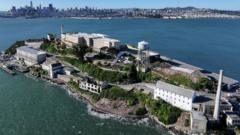---
In an unexpected move, former President Donald Trump has reiterated his desire to reopen Alcatraz Island, the historically infamous prison located in San Francisco Bay. Notorious for housing high-profile criminals like Al Capone and for its notorious escape attempts, Alcatraz has transitioned into a popular tourist attraction with over 1.4 million visitors annually. Trump claims that the prison could serve as a strong symbol of law and order in the U.S. while housing dangerous offenders.
Despite Trump's enthusiasm, prison experts and historians cast significant doubts on the viability of such an initiative. Alcatraz, closed in 1963 due to its exorbitant operational costs—reportedly three times higher than other federal prisons—remains in a state of disrepair, with crumbling infrastructure and outdated facilities. Hugh Hurwitz, a former acting director of the Bureau of Prisons, dismissed the idea as unrealistic, emphasizing the need for complete renovation rather than minor repairs.
The logistical challenge associated with reopening Alcatraz extends beyond physical conditions. As Jolene Babyak, a noted Alcatraz historian, elaborated, the infrastructure originally designed for 500 inmates would now require modern solutions for waste management, electricity, and security—facets that are absent in its current state. With the potential cost per inmate skyrocketing, experts believe it is financially unfeasible to operate the prison.
Although Trump's remarks have revived interest in Alcatraz's storied past, many question whether the vision aligns with the realities of modern corrections or merely serves as a provocative political narrative.
In an unexpected move, former President Donald Trump has reiterated his desire to reopen Alcatraz Island, the historically infamous prison located in San Francisco Bay. Notorious for housing high-profile criminals like Al Capone and for its notorious escape attempts, Alcatraz has transitioned into a popular tourist attraction with over 1.4 million visitors annually. Trump claims that the prison could serve as a strong symbol of law and order in the U.S. while housing dangerous offenders.
Despite Trump's enthusiasm, prison experts and historians cast significant doubts on the viability of such an initiative. Alcatraz, closed in 1963 due to its exorbitant operational costs—reportedly three times higher than other federal prisons—remains in a state of disrepair, with crumbling infrastructure and outdated facilities. Hugh Hurwitz, a former acting director of the Bureau of Prisons, dismissed the idea as unrealistic, emphasizing the need for complete renovation rather than minor repairs.
The logistical challenge associated with reopening Alcatraz extends beyond physical conditions. As Jolene Babyak, a noted Alcatraz historian, elaborated, the infrastructure originally designed for 500 inmates would now require modern solutions for waste management, electricity, and security—facets that are absent in its current state. With the potential cost per inmate skyrocketing, experts believe it is financially unfeasible to operate the prison.
Although Trump's remarks have revived interest in Alcatraz's storied past, many question whether the vision aligns with the realities of modern corrections or merely serves as a provocative political narrative.




















